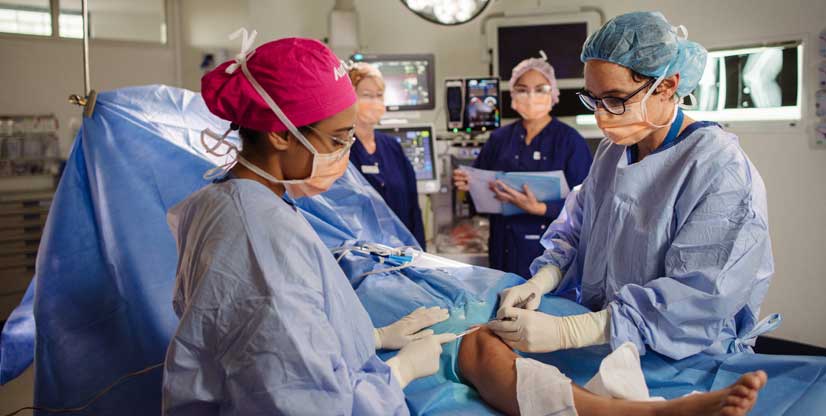Clinics & services
Nerve & tendon transfer surgery
Spasticity-related surgery
- Home
- Clinics & services
- Surgical procedures
- Nerve & tendon transfer surgery
- Frequently asked questions
- Spasticity-related surgery
What is spasticity?
Spasticity occurs in individuals who have a medical condition or injury which affects their central nervous system. This includes spinal cord injury, acquired brain injury, cerebral palsy, stroke and multiple sclerosis. The damage to the central nervous system results in changes in the signals between the brain and the muscles and can lead to a muscle becoming more excitable. The individual feels this excitation as tightness or pulling in their muscles. Over time, the body adjusts to the tightness sometimes by muscle and tendon shortening (contracture) and joints becoming immobile or stiff.
What can be done?
Prior to referral to the Upper Limb Program, most people have tried a large number of different treatments to reduce the impact of their spasticity. These are likely to have included medication, stretching, splinting, active exercise, electrical stimulation and botulinum toxin injections. The Upper Limb Program also uses these treatments in the first instance but we can also offer surgical improvements for problem spasticity, which will have a longer lasting effect. Examples of these procedures include:
- Tendon lengthening: refers to several surgical procedures used to lengthen the tendon of a spastic muscle so that the joint can rest in a more normal position.
- Tendon transfers: refers to using the tendon of a spastic muscle and re-routing the tendon to insert it into a different point, to hold the joint in a different, more functional, position. Usually the muscle is moved to assist the opposing action (as below) so as to restore balance.
- Joint releases: refers to releasing the capsule and structures around a joint, which have tightened to allow the joint to be positioned more naturally.
Will surgery make my hand/arm work like it did before?
No. Surgery is unable to repair the damage caused to the central nervous system. Surgery aims to minimise the functional impact of the spastic muscle pulling on the joint, by lengthening the tendon or altering the direction in which it pulls. While very occasionally patients report some active movement which is ‘unmasked' by the surgery, the most common benefits include relieved discomfort, easier hygiene and dressing and a more natural looking and relaxed hand/arm.
What does the surgery involve?
Surgery is completed by one or two experienced plastic and reconstructive surgeons at the Austin Hospital. Surgery occurs under a general anaesthetic and takes two to four hours. Most people are in hospital for one or two nights following surgery, depending on the extent of the surgery.
What happens after surgery?
What you require after surgery depends on the surgery that you have. You may have some increased care or equipment needs. You are also likely to need to wear a splint full time for 3-6 weeks and then at night for 3 months after surgery. In some instances, it will be recommended that your wear the splint ongoing at night to avoid recurrence of the contractures. You may also have specific stretching exercises to be done several times per day independently or with a carer. You will need to be able to attend Royal Talbot Rehabilitation Centre for review with the surgeons and hand therapy on multiple occasions. If you have a local therapist, they may be able to assist with some of the rehabilitation.
How much does surgery cost?
The surgery and therapy at Royal Talbot Rehabilitation Centre is performed within the Victorian Public Health System. No payment is required for patients who are eligible for health care under Medicare or who have compensation. You (or your compensation body) would be responsible for transport to and from appointments, equipment hire, increased care needs immediately following surgery, exercise equipment and private hand therapy if needed. Self-funded international clients or those not covered by Medicare can be treated by the team via the private healthcare system.
How do I organise an assessment?
Anyone with a neurological condition can contact the Upper Limb Program therapists to discuss their situation. If you meet the initial criteria, you will be seen at the clinic. If appropriate please discuss with your rehabilitation consultant, GP or treating staff as they may also refer.
At the clinic, you will meet the reconstructive plastic surgeons and the occupational therapists. They will assess your current upper limb function and talk with you about your goals. The surgeons will answer your questions and discuss what procedures may be best for you. The surgeons may suggest another type of treatment if that is more appropriate.
Where do I find out more information?
You can get more information by talking to your rehabilitation consultant, GP or by contacting the Upper Limb Program.
The upper limb program can also put you in touch with others who have had surgery for spasticity, but remember every person is slightly different.


